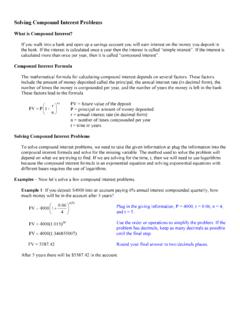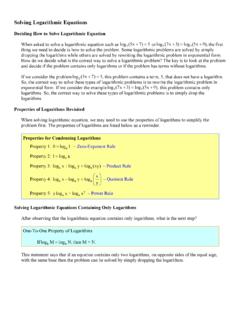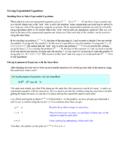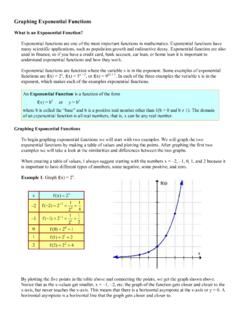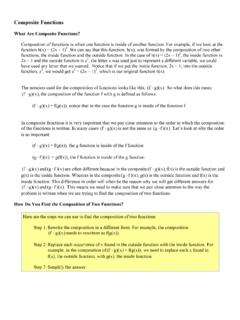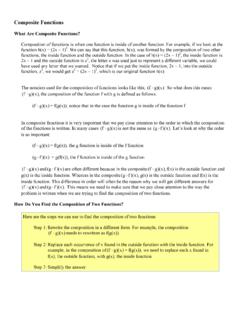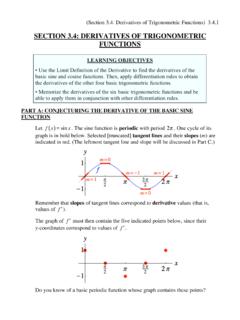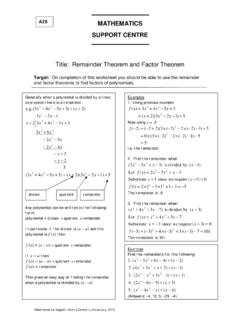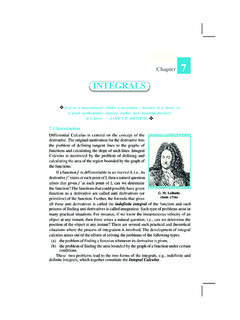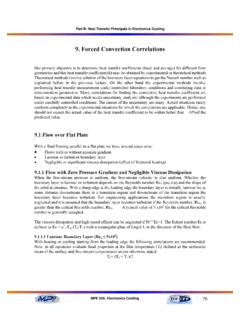Transcription of Inverse Functions - Mesa Community College
1 Inverse Functions What is anInverse Function? An Inverse function is a function that will undo anything that the original function does. For example, we all have a way of tying our shoes, and how we tie our shoes could be called a function. So, what would be the Inverse function of tying our shoes? The Inverse function would be untying our shoes, because untying our shoes will undo the original function oftying our shoes. Let s look at an Inverse function from a mathematical point of view. Consider the function f(x) = 2x 5. If we take any value of x and plug it into f(x) what would happen to that value of x?
2 First,the value of x would get multiplied by 2 and then we would subtract two mathematical operations that are taking place in the function f(x) are multiplication and subtraction. Now let s consider the Inverse function. What two mathematical operations would be needed to undo f(x)?Division and additionwould be needed to undo the multiplication and subtraction. A little farther down the page we will find the Inverse of f(x) = 2x 5, and hopefully the Inverse functionwillcontainboth division and addition(see example 5). Notation If f(x) represents a function, then the notation 1 f (x), - read f Inverse of x , will be used to denote the Inverse of f(x).
3 Similarly, the notation 1 g (x), - read g Inverse of x , will be used to denote the Inverse of g(x). Does the Function have anInverse? Not all Functions have an Inverse , so it is important to determine whether or not a function has an Inverse before we try and find the Inverse . If a function does not have an Inverse , thenwe need to realize the functiondoes not have an Inverse so we do not waste time trying to find something that does not exist. So how do we know if a function has an Inverse ?To determine if a function has an Inverse function, we need to talk about a special type of function called a One to One Function.
4 Aone to one function is a function where each input (x value) has a unique output (y value). To put it another way, every time we plug in a value of xwe will get a unique value of y,the same y value will never appear more than once. A one to one function is special because onlyone to one Functions have an Inverse function. Examples Now let s look at a few examples to help demonstrate what aone to one function is. Example 1: Determine ifthe function f = {(7, 3), (8, 5), ( 2, 11), ( 6, 4)} is a one to one function. The function f is a one to one functionbecause each of the y values in the ordered pairs is unique none of the y values appear more than once.
5 Since the function f is a one to one function,the function fmust have an Inverse . Note: 1 1 f (x). f(x) - It is very important not to confuse function notation with negative exponents. Note: Only One to One Functions have an Inverse 2: Determine if the function h = {( 3, 8), ( 11, 9), (5, 4), (6, 9)} is a one to one function. The functionh is not aone to one function because the y value of 9 is not unique the y value of 9 appears more than once. Since the function h is not aone to one function, the functionh does not have an Inverse . Remember that onlyone to one function have an Inverse . Is the Function a One to One Function?
6 We can determine if Functions are one to one by looking at ordered pairs and determining if each of the y values is unique, but what if we do not have ordered pairs? We could create ordered pairs by plugging different x values into the function and finding the corresponding y values giving us some ordered pairs. Rather than spending time creating ordered pairs, why not consider looking at the entire graph of the function instead? By looking at the entire graph rather than a few points, we should stillbe able to determine if the function is a one to one functionor not. In looking at the graph of the function we can determine if a function is a one to one functionor notby applying the HorizontalLine Test,or the graph of the function passes the Horizontal Line Test, then the function is a one to one function.
7 If the graph of the function fails the Horizontal Line Test, then the function is not a one to one function. By applying the Horizontal Line Test not only can we determine if a function is a one to one function, but more importantly we can determine if a function has an Inverse or not. Examples Now let s look at a few examples to help explain the HorizontalLine Test. Example 3: Determine ifthe function f(x) = 3 x 2 4 -+ is a one to one function. To determine if f(x) is a one to one function, we need to look at the graph of f(x). Since f(x) is a linear equation the graph of f(x) is a line with a slope of 3/4 and a y intercept of (0, 2).
8 In looking at the graph, you can see that any horizontal line (shown in red) drawnon the graph willintersect the graph of f(x) onlyonce. Therefore, f(x) is a one to one functionand f(x) must have an Inverse . Horizontal Line Test The HLT says that a function is a one to one function if there is no horizontal line that intersects the graph of the function at more than one 4: Determine if the function g(x) = x 3 4x is a one to one function. To determine if g(x) is a one to one function, we need to look at the graph of g(x). In looking at the graph, you can see that the horizontal line (shown in red) drawn on the graph intersects the graph of g(x) more than once.
9 Therefore, g(x) is not a one to one functionand g(x) does not have an Inverse . How to Find the Inverse Function Now that we have discussed what an Inverse function is, the notation used to represent Inverse Functions , one to one Functions , and the HorizontalLine Test, we are ready to try and find an Inverse function. By following these 5 steps we can find the Inverse function. Make sure that you follow all 5 steps. Many people will skip step 1 and just assume that the function has an Inverse however, not every function has an Inverse , because not every function is a one to one function. Only Functions that pass the Horizontal Line Test are one to one Functions and only one to one Functions have an Inverse .
10 Here are the steps required to find the Inverse function: Step 1: Determine if the function has an Inverse . Is the function a one to one function? If the function is a one to one function, go to step 2. If the function is not a one to one function, then say that the function does not have an Inverse and stop. Step 2: Change f(x) to y. Step 3: Switch x and y. Step 4: Solve for y. Step 5: Change y back to ). x ( f 1 -Examples Now let s use the steps shown above to work through some examples of finding Inverse Functions . Example 5: Iff(x) = 2x 5, find the Inverse . This functionpasses the Horizontal Line Test which means it is a one to one functionthat has an Inverse .
